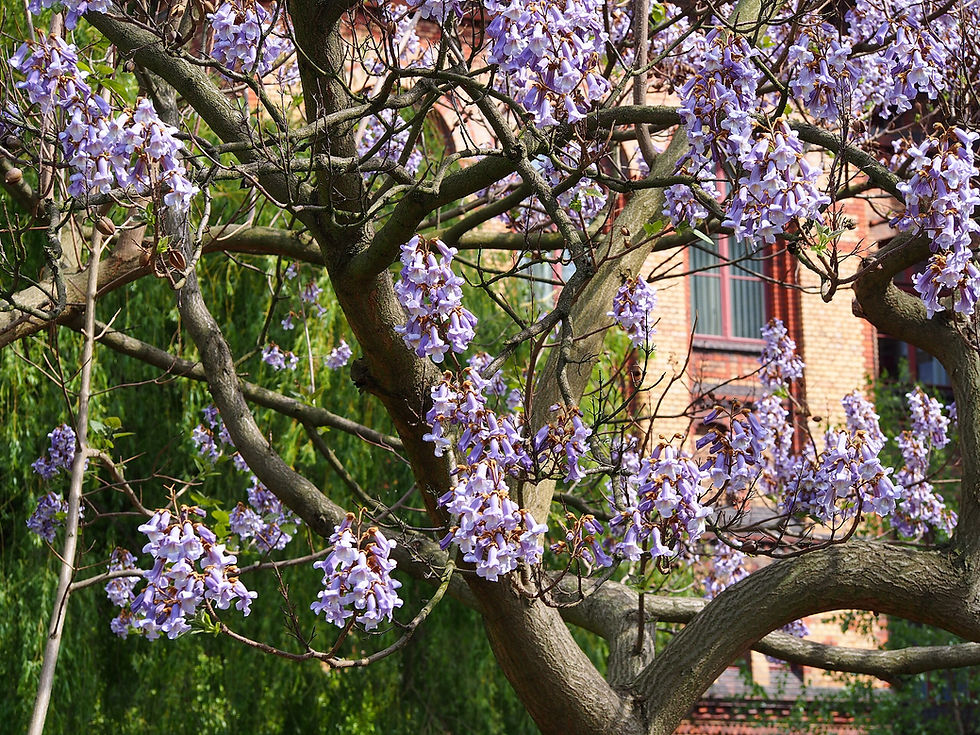TREES, PLEASE! Your Nose Knows to Sense Scents
- k-england
- Aug 1
- 3 min read
By Robin Y. Rivet, for Let’s Talk Plants! August 2025.

Your Nose Knows to Sense Scents
Can you smell a good tree? Sticking with what’s available the day you go shopping is ill-advised. Be patient. This is likely a 100-year investment. Do you also fancy a tree swing, showy flowers, a shaded seating area, or succulent fruit? One trait too few people consider is fragrance. Sensory whiffs can sneak out from many flowering, fruiting and coniferous trees of all shapes and sizes. Some are common, others not, and a few might surprise you.
Legendary fragrance is emitted from Ylang-Ylang - Cananga odorata. This rare “perfume tree” thrives surprisingly well in our region. It grows fast to 30’, tolerates short freezes, and has drooping, intensely scented flowers that appear any time of year. Another “nose-stopper” is Michelia champaca which craves our local soils. The fragrant species flower is yellow, but there’s also an ‘Alba’, but no discussion about floral bouquet is complete without magnolias.

Southern magnolia – Magnolia grandiflora (and its hybrids vary from 20’-100’ tall) prosper in this region. Honestly, the exquisitely fragrant, white dinner-plate flowers are difficult to beat. You won’t regret growing one. It’s no surprise that these three highly scented species are related.
Edible fruit trees with enticing smells are always a good bet. True double delights. Consider the cherimoya – Annona cherimola. The tasty, tropical orbs ripen in December, but all summer long the highly perfumed flowers will permeate your garden. Plus, you can teach your friends hand-pollination amidst the semi-evergreen, velvety foliage. All citrus flowers are also heavenly. The Eureka lemon - Citrus limon ‘Eureka’ can produce fruit all year, doesn’t need heat to sweeten, and may even be grown in a large pot - if necessary. Plant near your kitchen to pluck and inhale.

Similar double-duty trees are the very-large Inga edulis - ice-cream bean; the medium-sized Japanese raisin tree - Hovenia dulcis; and all shrubby Elaeagnus flowers are fragrant, although the hybrid Elaeagnus x ebbingei is my favorite.
Native conifers generate a woodsy aroma that appeals to many people. Our incense cedar and California juniper come to mind... Although the California buckeye - Aesculus californica native is early deciduous, it displays clusters of very fragrant, showy pink or white flowers, plus fall color and white winter bark.

You like purple? Although jacaranda has a light scent, it’s not as intense as the lavender inflorescence of the rapid-growth Empress tree - Paulownia tomentosa, or the nitrogen-fixing purple robe locust - Robinia 'Purple Robe'. Butterflies will flock to the alluring violet and vanilla-scented Brazilian skyflower - Duranta erect, and it can bloom all year!
Purple-leaf acacia – Acacia baileyana ‘Purpurea’ has purplish foliage, although all acacias sport scented yellow orbs which typically “wow” in late winter, while the southwest native goldenball leadtree - Leucaena retusa has similar yellow puffballs during the rest of the year. With a tall, narrow open canopy, and a surprisingly strong fragrance from its golden flowers during warmer months, the sweetshade - Hymenosporum flavum needs more urban enthusiasts.

If you want really showy and sweet, nothing compares to the huge trumpets of Brugmansias, but you’ll need to wait until late afternoon for their intense perfume to percolate, as these attract nighttime moths and bats for pollination.
Wait, there’s some sleepers. The re-classified camphor - Camphora officinarum is not known for its inflorescence but walk underneath one in spring for a “clean laundry” scent. There’s nothing quite like it. Ditto the common myrtle – Myrtus communis with its sweet, white flowers and highly aromatic foliage, while Viburnum odoratissimum - sweet viburnum’s name didn’t just pop out of a hat.

Finally, if you’re a rare plant fanatic who prefers oddity, where even a weird odor would be compelling, plant the gorgeous, maroon-flowering sausage tree - Kigelia africana. Then consider throwing a Halloween party under it.

Member Robin Rivet is a ISA Certified Arborist &
UCCE Master Gardener
contact her: treetutor@gmail.com
